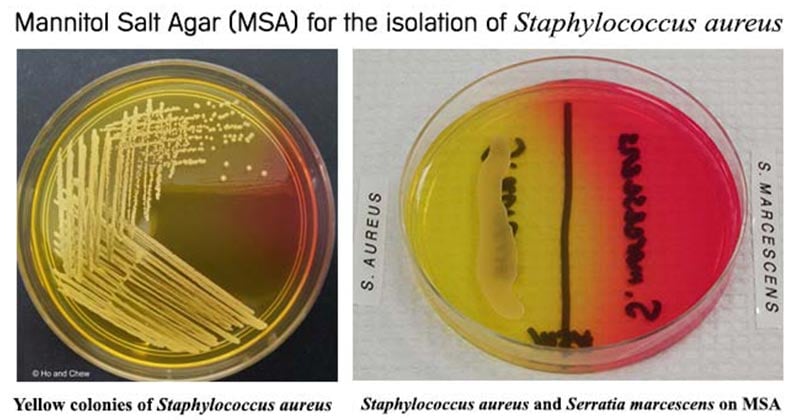Mannitol Salt Agar (MSA) is used as a selective and differential medium for the isolation and identification of Staphylococcus aureus from clinical and non-clinical specimens. It is recommended for the detection and enumeration of coagulase-positive Staphylococci in milk, food, and other specimens and encourages the growth of a group of certain bacteria while inhibiting the growth of others.
Interesting Science Videos
Principle of Mannitol Salt Agar (MSA)
Mannitol Salt Agar contains beef extract and proteose peptone, which makes it very nutritious as they provide essential growth factors and trace nutrients such as nitrogen, vitamins, minerals, and amino acids essential for growth. The medium contains a 7.5% concentration of sodium chloride which results in the partial or complete inhibition of bacterial organisms other than staphylococci. Mannitol is the fermentable carbohydrate source, fermentation of which leads to acid production. Staphylococcus aureus grows on this medium and ferments mannitol to produce yellow colonies. Most coagulase-negative species of Staphylococci and Micrococci do not ferment mannitol and grow as small red colonies. The color of the colonies and the medium is due to the reactivity of phenol red (indicator) to the pH of the medium. Phenol red is red at pH 8.4 and phenol red is yellow at pH 6.8. Agar is the solidifying agent. In addition, 5% v/v Egg Yolk Emulsion can be added to a medium which enables the detection of lipase activity of staphylococci along with mannitol fermentation. The salt clears the egg yolk emulsion and lipase production is detected as a yellow opaque zone around the colonies.
Composition of Mannitol Salt Agar (MSA)
| Ingredients | Gms/Litre |
| Proteose peptone | 10.0 |
| Sodium chloride | 75.0 |
| D- mannitol | 10.0 |
| Beef extract | 1.0 |
| Phenol red | 0.025 |
| Agar | 15.0 |
Final pH 7.4 +/- 0.2 at 25ºC.
Preparation of Mannitol Salt Agar (MSA)
- Suspend 111 grams of Mannitol Salt Agar in 1000 ml of distilled water.
- Boil to dissolve the medium completely.
- Sterilize by autoclaving at 15 lbs. pressure (121°C) for 15 minutes.
- If desired, sterile Egg Yolk Emulsion (E7899) can be added to a final concentration of 5% v/v after autoclaving.
- Pour cooled Mannitol Salt Agar into sterile petri dishes and allow to cool to room temperature.
Results on Mannitol Salt Agar (MSA)

| Organisms | Results |
| Staphylococcus aureus | Yellow colonies surrounded by the yellow zone |
| Staphylococcus epidermidis | Pink or Red colonies |
| Micrococci | Red colonies |
| Escherichia coli | No growth |
Uses of Mannitol Salt Agar (MSA)
- It is used for the selective isolation and differentiation of Staphylococcus aureus from clinical samples.
- It is also used for the enumeration of staphylococci in food and dairy products.
- This medium is also included in the Bacteriological Analytical Manual for cosmetics testing.
- It is also used in the bacteriological examination of swimming pool water, spas and drinking water using membrane filtration.
Limitations
- Several Staphylococcus species other than aureus are mannitol positive and produce yellow colonies surrounded by yellow zones on this medium (e.g. S. capitis, S. xylosus, S. cohnii, S. sciuri, S. simulans, and other species). Therefore, further biochemical tests are necessary for the identification of S. aureus or other species.
- Most organisms other than staphylococci are inhibited by the high salt concentration found in Mannitol Salt Agar except for some halophillic marine organisms.
- A few strains of Staphylococcus aureus may exhibit a delayed fermentation of mannitol. Negative plates should be re-incubated overnight before discarding.
- Presumptive Staphylococcus aureus must be confirmed with a coagulase test.
References
- HiMedia.
- Mannitol Salt Agar (MSA) (Chapman Medium) European Pharmacopoeia, Usp.
- Hardy Diagnostics.
- Mannitol Salt Agar. Dehydrated Culture Media. Thermo Fisher Scientific Inc.
- https://en.wikipedia.org/wiki/Mannitol_salt_agar
- http://microbeonline.com/mannitol-salt-agar-msa-composition-uses-and-colony-characteristics/
- http://www.vumicro.com/vumie/help/VUMICRO/Mannitol_Salt_Agar.htm
- https://microbiologyinfo.com/mannitol-salt-agar-for-the-isolation-of-staphylococcus-aureus/
- https://www.sigmaaldrich.com/content/dam/sigma-aldrich/docs/Sigma/Datasheet/4/m9052dat.pdf

This is really helpful
very useful